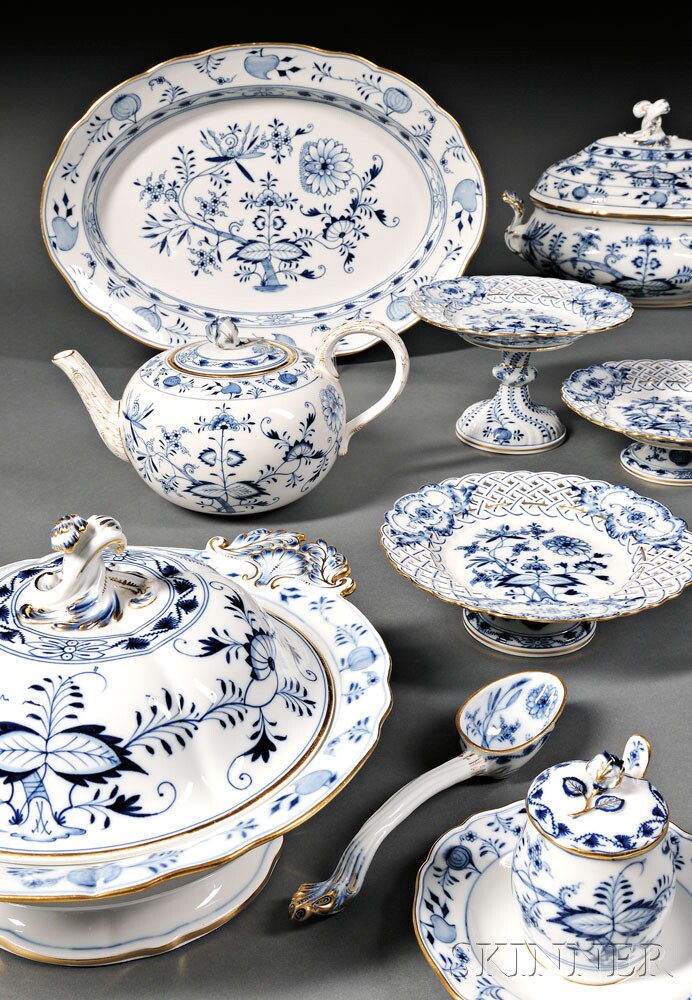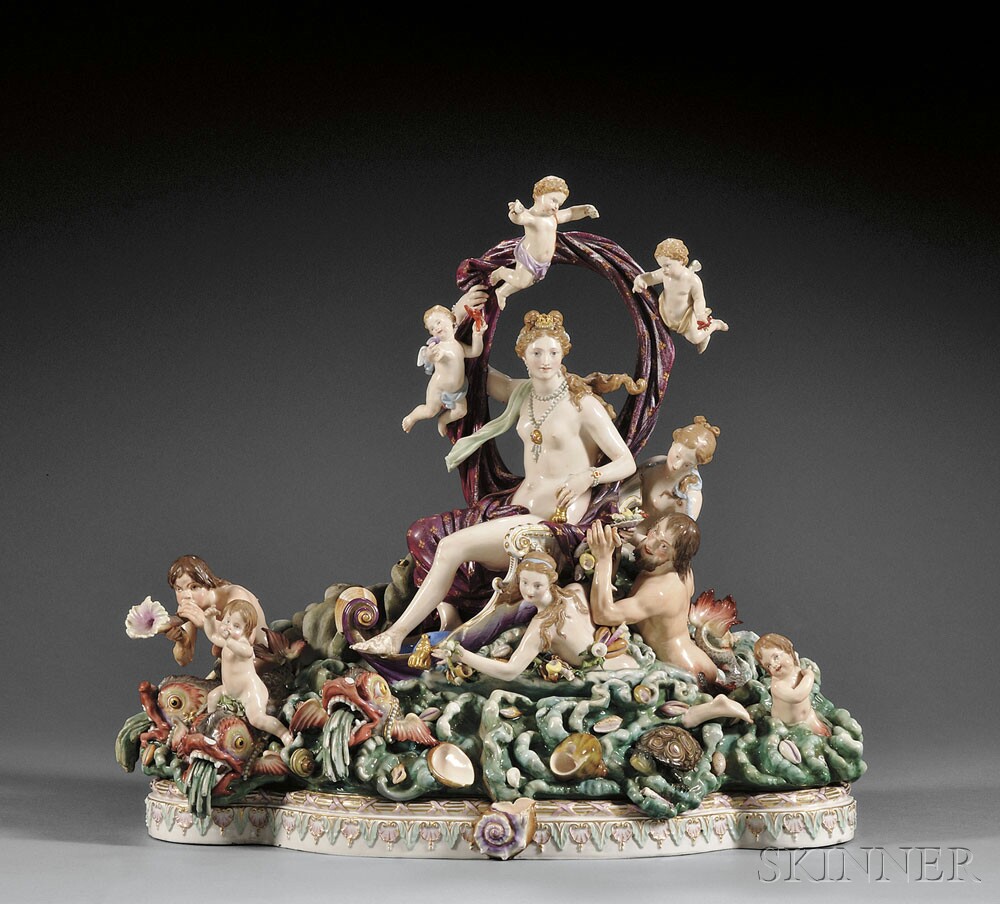
Extensive Meissen Blue Onion Dinner Service, Germany, c.1900, to be offered at auction April 5, 2014 (Lot 378, Estimate $7,000-$9,000)
Since the early 18th century, Meissen has represented the highest quality in German porcelain, and has offered a wide variety of objects, from figures and figural groups to tea wares, dinner services, vases, clock cases, ewers, mirror frames, and so much more. Meissen produced lines of redwares, stonewares, and easily recognizable polychrome-enameled and gilded porcelain figures. Many of their patterns are easily recognizable — you are likely familiar with the ever-popular Blue Onion design. Our April 5, 2014 European Furniture & Decorative Arts auction in Boston features a nice example of a Blue Onion dinner service.
Early wares from the 18th century seldom appear on the market in any quantity, and when they do, they command high prices due to their scarcity and popularity with collectors. 19th and early 20th century pieces – especially figures – are much more abundant, and often appear at auction and in antique galleries. These collectible characters amuse the eye with amazing delicacy and details. From animals to bucolic lovers, to monkey bands and mythology, there are subjects to complement any collector’s personality.
How do you know which pieces are a good buy? And how do you take care of Meissen porcelain? These 5 tips will help you start to understand the quality of Meissen porcelain.
1. Pay attention to density and weight
The quality of the modeling and decoration may be the first thing you notice when looking at a Meissen piece, but the density and weight of the porcelain itself matters, too, and indicates a higher quality of workmanship and materials. This added heft is especially apparent in dinner wares (though it is true for figures as well). Royalty as well as the upper classes have feasted off of Meissen plates, platters, and other dinner wares for well over 200 years.
2. Check the maker’s mark for crossed swords
The mark of crossed swords represents Meissen. However, the manufacturer made subtle changes to the mark over the years. Also, lesser German manufacturers often copied Meissen’s designs, and some competitors used a vaguely similar mark, a fact that may confuse or even deceive a novice collector. As similar as these copycat marks are, inferior quality is the telltale sign that these pieces are not genuine Meissen.
3. Understand condition and restoration
Condition is an important consideration when collecting any ceramics, as these pieces are almost always multiples. If a piece has a chip, crack, or significant wear, the value will drop compared with the same piece in pristine condition. For the most part, these are ornamental wares and most have been displayed in vitrines and china cabinets with minimal handling. Collectors of Meissen figures, however, recognize and accept the likelihood that fingers, toes, and small flowers may have been restored.
4. Clean carefully and sparingly!
Dusting and washing is always a challenge, considering the intricate nature of Meissen figures and groups. Keeping figures in a closed display cabinet helps reduce the necessity for cleaning. Take special care when cleaning items with restorations. Often, attempts to clean will change the finish or remove older repairs.
5. Educate yourself
Many good books teach about the different designs, styles, and marks of Meissen porcelain. However, there’s nothing like seeing the real thing at auction previews, antique shops, shows, and the many museums that display a nice variety of wares.
Meissen porcelain has a rich heritage of creativity, artistry, and cultural significance in addition to its excellent craftsmanship. Knowing this background helps collectors appreciate each piece more. Beginning in the early 1700s, Meissen was the first porcelain produced in Europe to compete with imports from China and Japan. Johann Friedrich Böttger and his colleagues are credited with this discovery, which was a turning point in European pottery. The famous crossed swords insignia, which was first used in 1720, is another important feature that collectors should look for because it is a sign of quality and authenticity.
In addition, Meissen objects frequently include elaborate hand-painted patterns that represent the aesthetic tastes of their time, ranging from floral themes to mythical images. Collectors can determine a piece’s approximate age and setting by becoming familiar with these patterns. Another piece of advice for collectors is to pay close attention to condition. Significant restorations or damage might affect value, even when minor flaws in older items might be acceptable. Owning exquisite items is only one aspect of collecting Meissen porcelain; another is fostering a connection with the rich history of European design and art. Every purchase has a backstory that provides insight into the customs, innovations, and preferences of the past.
Skinner regularly hosts Fine Ceramics auctions featuring Meissen porcelain, and our auction previews are always free and open to the public.
To this date, Meissen porcelain seems to have maintained its value, while the market for other categories of ceramic wares has softened. In my opinion, the market for Meissen remains healthy because of a wide, international collector base. Also, the regular availability of 19th and 20th century pieces keeps the thrill of the hunt alive and collections growing. However, as I’ve mentioned before, the low level of interest from young collectors in ceramics and other antiques is a cause for concern. I can only hope that quality speaks for itself, and Meissen certainly means quality!




I own a Meissen vase that my parents brought back from Fathers Army Tour in early 1950’s.
Any suggestions on how to have it appraised and sold would be appreciated.
Thank you, John Maciejczyk..4848921660
I have a octagon coffee table it’s very high really neat pattern beautiful wood Mesman table. It had a label still there green and silver or green and gold I saw one on auction well it was up to 9000.00 dollars so it must be special. Thankyou. Adair Sue Sturgis
I have an antique Meissen charger, which someone dated to 1820. It was given to my grandmother, as the original owners didn’t want it after it was cracked and repaired. Wondering if I should pay for the cost of repairing it, found a guy in Conn. to do it. Will send photos.
I inherited many pieces of Meissen. My uncle spent much time in Germany before and after WWII. He sent back hundreds of pieces home. His ambition was to open an antique store in New York.
I would like to sell the collection so that others can enjoy it but don’t know how to proceed, and we are compensated fairly.
Hello Robert,
Please reach out to the Appraisal Services Department at evaluations@skinnerinc.com. or submit our Auction Evaluation request form: https://www.skinnerinc.com/selling/auction-evaluation-form/ Thank you very much.
What are the fees to have a piece appraised? I have a large round, blue deer Meissen platter that was hanging on my parents wall and I need to get it appraised for insurance. Naturally, I hate to spend $500 to get something appraised for just $150. Any suggestions?
Hello Eric, There is no fee for an auction estimate. There is a cost only if you need a written appraisal for legal purposes. Please submit images and a detailed description to the Appraisal Services Department: https://www.skinnerinc.com/selling/sell-at-auction/ or at evaluations@skinnerinc.com and our Appraisals Department will return any information that we can to you as well as an auction evaluation. Thank you!